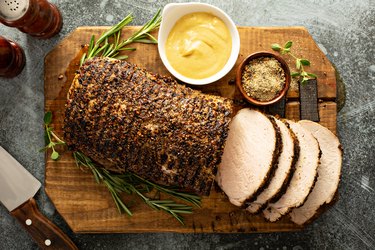
Gammon is the meat obtained from the hind leg of the pig. It is very similar to ham, and in fact, it is sometimes described as a type of ham. The main difference between gammon and traditional ham is the way the two are cured.
Both are cured with brine, however, ham is cured by first cutting the meat from the carcass and subsequently adding salt to the meat, while gammon is cut away from the carcass after salting. Gammon tends to have a stronger and saltier flavor than ham.
Video of the Day
Video of the Day
Calories, Fat and Protein
A 3-ounce serving of pork contains about 122 calories, 3 grams of fat and 22 grams of protein, according to the USDA Nutrient Database. It is, therefore, relatively high in calories, and should be eaten in moderation.
In addition, of the 15 grams of fat, about 6.5 grams are of the saturated kind — a type of fat associated with heart disease. The American Heart Association recommends that less than 7 percent of your daily calorie intake come from saturated fat.
For a person eating 2,000 calories a day, this works out to be 16 grams of saturated fat daily. A grilled gammon steak contains 16 grams of protein and 0 grams of carbohydrates per 100 grams.
Minerals
Meat is a good source of minerals. According to McCance and Widdowson's the Composition of Foods, gammon is rich in copper and magnesium. Magnesium is needed for healthy bones, teeth and the immune system and for proper muscle and nerve function. Copper is essential for proper iron metabolism and for healthy red blood cells.
Gammon is also a source of iron and zinc, but it contains significantly less of these minerals than darker meats such as beef. Iron is used for red blood cell production while zinc is essential for sexual development and wound healing. Gammon tends to be high in salt, which is associated with high blood pressure.
Vitamins
Gammon is a source of the B-vitamins thiamine, riboflavin, niacin, B-6, B-12 and biotin, reports the Composition of Foods. Your body uses thiamine and riboflavin to convert foods to energy, while niacin is used for the metabolism of fatty acids.
Vitamin B-6 is critical for the metabolism of proteins and in the regulation of glycogen stores. Vitamin B-12 is essential for healthy red blood cell and nerves, and biotin is needed for glucose metabolism in the liver. Gammon also contains small amounts of vitamin D, which is needed for healthy bones and teeth.
Tip
- Always choose lean cuts of gammon, as these contain less fat and calories and are healthier for you.
- When cooking, avoid frying and go for roasting and boiling instead.
- Don’t add salt to gammon dishes, as the gammon itself is already high in salt.
- You are encouraged to choose organic varieties, as these are more environmentally friendly and have better animal welfare standards.